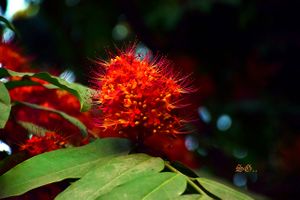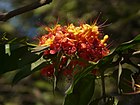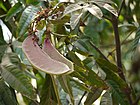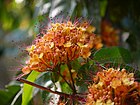Note: This is a project under development. The articles on this wiki are just being initiated and broadly incomplete. You can Help creating new pages.
Difference between revisions of "Saraca asoca - Ashoka, Ashoka tree"
(→External Links) |
|||
| (4 intermediate revisions by 3 users not shown) | |||
| Line 1: | Line 1: | ||
[[File:ASHOKa (1).jpg|thumb|right|''Ashoka flolwer & leaf'']] | [[File:ASHOKa (1).jpg|thumb|right|''Ashoka flolwer & leaf'']] | ||
| − | + | '''Ashoka''' tree is one of the most legendary and sacred trees of India and holds valuable importance in Hinduism, Buddhism, and Jainism. It is an evergreen tree 15-20 meters high. Its family is Ceasalpiniaceae.<ref name="Family name"/> | |
| − | '''Ashoka''' | ||
| − | |||
==Uses== | ==Uses== | ||
{{Uses|Menstrual cramps}}, {{Uses|Uterine bleeding}}, {{Uses|Uterine fibroids}}, {{Uses|Haemorrhoids}}, {{Uses|Internal bleeding}}, {{Uses|Blotches}}, {{Uses|Pimples}}, {{Uses|Diarrhea}}, {{Uses|Sore throats}}, {{Uses|White discharge}}, {{Uses|Excess vaginal bleeding}}, {{Uses|Menstrual disorder}}. | {{Uses|Menstrual cramps}}, {{Uses|Uterine bleeding}}, {{Uses|Uterine fibroids}}, {{Uses|Haemorrhoids}}, {{Uses|Internal bleeding}}, {{Uses|Blotches}}, {{Uses|Pimples}}, {{Uses|Diarrhea}}, {{Uses|Sore throats}}, {{Uses|White discharge}}, {{Uses|Excess vaginal bleeding}}, {{Uses|Menstrual disorder}}. | ||
| Line 13: | Line 11: | ||
==Common names== | ==Common names== | ||
| − | {{Common names|kn=Achenge, Ashoka|ml=Asokam, Hemapushpam|sa=Anganapriya, Apashaka|ta=Anagam, Ashogam|te=Asokamu, Vanjulamu|hi=Ashok, Asok|en=Ashoka tree|mr=Ashok|gu=Ashoka|pa=Asok|ks=Ashok}} | + | {{Common names|kn=Achenge, Ashoka ಅಶೋಕ|ml=Asokam, Hemapushpam|sa=Anganapriya, Apashaka|ta=Anagam, Ashogam|te=Asokamu, Vanjulamu|hi=Ashok, Asok|en=Ashoka tree|mr=Ashok|gu=Ashoka|pa=Asok|ks=Ashok}}<ref name="Common names"/> |
==Properties== | ==Properties== | ||
| Line 39: | Line 37: | ||
===Flower=== | ===Flower=== | ||
| − | {{Flower|Unisexual|7.5- 10 cm| | + | {{Flower|Unisexual|7.5- 10 cm|Orange, white|7 or 8|Inflorescence dense corymbs}} |
===Fruit=== | ===Fruit=== | ||
| − | {{Fruit| | + | {{Fruit|Oblong|15 x 4.5 cm|Clearly grooved lengthwise, Lowest hooked hairs aligned towards crown||4-8}} |
===Other features=== | ===Other features=== | ||
==List of Ayurvedic medicine in which the herb is used== | ==List of Ayurvedic medicine in which the herb is used== | ||
| − | |||
==Where to get the saplings== | ==Where to get the saplings== | ||
| Line 54: | Line 51: | ||
==How to plant/cultivate== | ==How to plant/cultivate== | ||
| − | Land preparation and fertilizer application Pits of size 45 cm × 45 cm × 45 cm are prepared at a spacing of 3 m × 3 m. The pits are weathered and refilled with topsoil after mixing with 10 kg FYM per pit. An additional 10 kg manure should be applied as the follow-up dose during October–November<ref name="How to plant/cultivate"/> | + | Land preparation and fertilizer application Pits of size 45 cm × 45 cm × 45 cm are prepared at a spacing of 3 m × 3 m. The pits are weathered and refilled with topsoil after mixing with 10 kg FYM per pit. An additional 10 kg manure should be applied as the follow-up dose during October–November.<ref name="How to plant/cultivate"/> |
==Commonly seen growing in areas== | ==Commonly seen growing in areas== | ||
| Line 62: | Line 59: | ||
<gallery class="left" caption="" widths="140px" heights="140px"> | <gallery class="left" caption="" widths="140px" heights="140px"> | ||
A so ka (in Tibetan) (2209868058).jpg | A so ka (in Tibetan) (2209868058).jpg | ||
| − | |||
| − | |||
Anganapriya (Oriya- ଅଙ୍ଗନାପ୍ରିଯ) (6781533842).jpg | Anganapriya (Oriya- ଅଙ୍ଗନାପ୍ରିଯ) (6781533842).jpg | ||
| − | |||
| − | |||
Apashoka (Sanskrit- अपशोक) (2334268617).jpg | Apashoka (Sanskrit- अपशोक) (2334268617).jpg | ||
| − | |||
| − | |||
Ashok (Hindi- अशोक) (6781535350).jpg | Ashok (Hindi- अशोक) (6781535350).jpg | ||
| − | |||
| − | |||
Ashok (Marathi- अशोक) (4591876281).jpg | Ashok (Marathi- अशोक) (4591876281).jpg | ||
| − | |||
| − | |||
Ashok (Nepali- अशोक) (6781532428).jpg | Ashok (Nepali- अशोक) (6781532428).jpg | ||
| − | |||
</gallery> | </gallery> | ||
| Line 83: | Line 69: | ||
<references> | <references> | ||
| − | <ref name="chemical composition">[http://www.stuartxchange.org/Asoka " | + | <ref name="chemical composition">[http://www.stuartxchange.org/Asoka Chemical Constituents]</ref> |
| + | <ref name="Common names">[https://sites.google.com/site/indiannamesofplants/via-species/s/saraca-asoca Common names]</ref> | ||
| − | <ref name="Leaf">[https://indiabiodiversity.org/species/show/18020 " | + | <ref name="Leaf">[https://indiabiodiversity.org/species/show/18020 Plant decsription]</ref> |
| + | <ref name="Family name">Karnataka Aushadhiya Sasyagalu By Dr.Maagadi R Gurudeva, Page no:25</ref> | ||
| − | <ref name="How to plant/cultivate">[http://e-charak.in/echarak/templates/Saraca%20asoca%20%20(Roxb.)%20de%20Willde.pdf | + | <ref name="How to plant/cultivate">[http://e-charak.in/echarak/templates/Saraca%20asoca%20%20(Roxb.)%20de%20Willde.pdf Planting in the field]</ref> |
</references> | </references> | ||
| Line 94: | Line 82: | ||
* [http://ijpsr.com/bft-article/antioxidant-and-haematoprotective-activity-of-the-saraca-indica-stem-bark/?view=fulltext Saraca asoca on INTERNATIONAL JOURNAL OF PHARMACEUTICAL SCIENCES AND RESEARCH] | * [http://ijpsr.com/bft-article/antioxidant-and-haematoprotective-activity-of-the-saraca-indica-stem-bark/?view=fulltext Saraca asoca on INTERNATIONAL JOURNAL OF PHARMACEUTICAL SCIENCES AND RESEARCH] | ||
* [http://ijpcsonline.com/files/73-533.pdf Saraca asoca on INTERNATIONAL JOURNAL OF PHARMACEUTICAL AND CHEMICAL SCIENCES] | * [http://ijpcsonline.com/files/73-533.pdf Saraca asoca on INTERNATIONAL JOURNAL OF PHARMACEUTICAL AND CHEMICAL SCIENCES] | ||
| − | * [http://tropical.theferns.info/viewtropical.php?id=Saraca+indica | + | * [http://tropical.theferns.info/viewtropical.php?id=Saraca+indica Saraca asoca on Useful trophical plants] |
[[Category:Herbs]] | [[Category:Herbs]] | ||
[[Category:Ayurvedic herbs that don't have seed photos]] | [[Category:Ayurvedic herbs that don't have seed photos]] | ||
[[Category:Fabaceae]] | [[Category:Fabaceae]] | ||
Latest revision as of 15:59, 5 August 2020
Ashoka tree is one of the most legendary and sacred trees of India and holds valuable importance in Hinduism, Buddhism, and Jainism. It is an evergreen tree 15-20 meters high. Its family is Ceasalpiniaceae.[1]
Contents
- 1 Uses
- 2 Parts Used
- 3 Chemical Composition
- 4 Common names
- 5 Properties
- 6 Habit
- 7 Identification
- 8 List of Ayurvedic medicine in which the herb is used
- 9 Where to get the saplings
- 10 Mode of Propagation
- 11 How to plant/cultivate
- 12 Commonly seen growing in areas
- 13 Photo Gallery
- 14 References
- 15 External Links
Uses
Menstrual cramps, Uterine bleeding, Uterine fibroids, Haemorrhoids, Internal bleeding, Blotches, Pimples, Diarrhea, Sore throats, White discharge, Excess vaginal bleeding, Menstrual disorder.
Parts Used
Chemical Composition
Flavonoids, two tannins, allagic acid, catechin, quercetin and quercitrin and Dihydroxy-benzaldehyde and tetramethyl hexadecen-1-ol compounds.[2]
Common names
| Language | Common name |
|---|---|
| Kannada | Achenge, Ashoka ಅಶೋಕ |
| Hindi | Ashok, Asok |
| Malayalam | Asokam, Hemapushpam |
| Tamil | Anagam, Ashogam |
| Telugu | Asokamu, Vanjulamu |
| Marathi | Ashok |
| Gujarathi | Ashoka |
| Punjabi | Asok |
| Kashmiri | Ashok |
| Sanskrit | Anganapriya, Apashaka |
| English | Ashoka tree |
Properties
Reference: Dravya - Substance, Rasa - Taste, Guna - Qualities, Veerya - Potency, Vipaka - Post-digesion effect, Karma - Pharmacological activity, Prabhava - Therepeutics.
Dravya
Rasa
Tikta (Bitter), Kashaya (Astringent)
Guna
Laghu (Light), Ruksha (Dry)
Veerya
Sheeta (cold)
Vipaka
Katu (Pungent)
Karma
Hridya, Visagna, Grahi, Varnya
Prabhava
Habit
Identification
Leaf
| Kind | Shape | Feature |
|---|---|---|
| Simple | Alternate | Leavesrae Distichous, stipules caducous; rachis pulvinate, 7-30 cm long |
Flower
| Type | Size | Color and composition | Stamen | More information |
|---|---|---|---|---|
| Unisexual | 7.5- 10 cm | Orange, white | 7 or 8 | Inflorescence dense corymbs |
Fruit
| Type | Size | Mass | Appearance | Seeds | More information |
|---|---|---|---|---|---|
| Oblong | 15 x 4.5 cm | Clearly grooved lengthwise, Lowest hooked hairs aligned towards crown | 4-8 | {{{6}}} |
Other features
List of Ayurvedic medicine in which the herb is used
Where to get the saplings
Mode of Propagation
How to plant/cultivate
Land preparation and fertilizer application Pits of size 45 cm × 45 cm × 45 cm are prepared at a spacing of 3 m × 3 m. The pits are weathered and refilled with topsoil after mixing with 10 kg FYM per pit. An additional 10 kg manure should be applied as the follow-up dose during October–November.[5]
Commonly seen growing in areas
Tropical area, Subtropical area, Himalayas
Photo Gallery
References
- ↑ Karnataka Aushadhiya Sasyagalu By Dr.Maagadi R Gurudeva, Page no:25
- ↑ Chemical Constituents
- ↑ Common names
- ↑ Plant decsription
- ↑ Planting in the field
External Links
- Ayurvedic Herbs known to be helpful to treat Menstrual cramps
- Ayurvedic Herbs known to be helpful to treat Uterine bleeding
- Ayurvedic Herbs known to be helpful to treat Uterine fibroids
- Ayurvedic Herbs known to be helpful to treat Haemorrhoids
- Ayurvedic Herbs known to be helpful to treat Internal bleeding
- Ayurvedic Herbs known to be helpful to treat Blotches
- Ayurvedic Herbs known to be helpful to treat Pimples
- Ayurvedic Herbs known to be helpful to treat Diarrhea
- Ayurvedic Herbs known to be helpful to treat Sore throats
- Ayurvedic Herbs known to be helpful to treat White discharge
- Ayurvedic Herbs known to be helpful to treat Excess vaginal bleeding
- Ayurvedic Herbs known to be helpful to treat Menstrual disorder
- Herbs with Bark used in medicine
- Herbs with Seeds used in medicine
- Herbs with Flowers used in medicine
- Herbs with common name in Kannada
- Herbs with common name in Hindi
- Herbs with common name in Malayalam
- Herbs with common name in Tamil
- Herbs with common name in Telugu
- Herbs with common name in Marathi
- Herbs with common name in Gujarathi
- Herbs with common name in Punjabi
- Herbs with common name in Kashmiri
- Herbs with common name in Sanskrit
- Herbs with common name in English
- Habit - Tree
- Index of Plants which can be propagated by Seeds
- Herbs that are commonly seen in the region of Tropical area
- Herbs that are commonly seen in the region of Subtropical area
- Herbs that are commonly seen in the region of Himalayas
- Herbs
- Ayurvedic herbs that don't have seed photos
- Fabaceae






